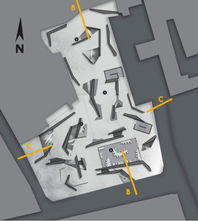
Architecture Memoir:
IMAGINARIUM
The architectural memoir work, titled "Imaginarium: An Essay on the Fictionalization of Traces in the Medina of Tunis," aims to explore the duality between trace and fiction, which is, the duality of the historical and the surreal imaginary.
Fiction cannot exist without a subjective or objective historical reference point. The creation of any imaginary world requires a return to a historical foundation of ancient civilizations or even recent events.
The intervention site will be the city of traces and the city of daydreams: the Medina of Tunis.
Within the dense fabric of the Medina, near the French Quarter, there is a conspicuous void: El Kherba, currrently a parking lot. This vacuum is a result of the bombings during the Second World War that targeted the French Quarter. "El Kherba" does not present ruins or remnants, but its name recalls its ruin. It represents a semiotic ruin.
On the other hand, Fondouk El Henna in this area represents a ruined, dilapidated space that continues to buzz with life and artisanal activities despite the physical degradation.
The intervention presents a cyclical journey that defines continuous interaction between contemporary artists and artisans (especially those of Fondouk), enriching both parallel sectors. The Imaginarium presents an alternative and playful vision of a "think tank."
The fictionalization of the space, therefore, creates an environment conducive to creation and contemplation.



